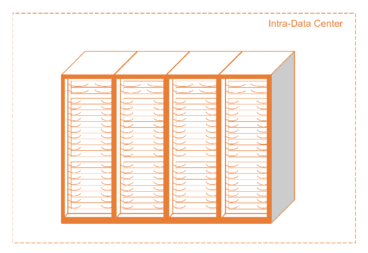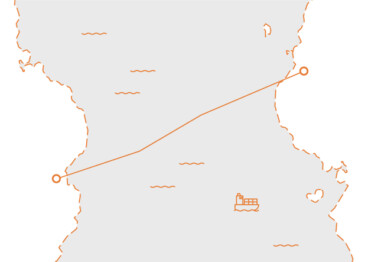Cost effective, high bandwidth, high performance solutions for optical networking applications
Data Center Interconnect for Cloud / AI
Large cloud infrastructure operators and internet content providers have increasingly been building global private networks using leased or owned dark fiber. These networks require high speed optical solutions to address the continuing growth of inter-datacenter traffic. Contributing to data center interconnect traffic growth is synchronization and load balancing to maximize the utilization of available data center resources. This traffic is also expected to grow with rising artificial intelligence/machine learning (AI/ML) applications.
Enterprises transitioning from operating their own data center to cloud-based services is driving host data center growth. The massive bandwidth interconnect requirements for these mega-data centers are driving demand for both performance-optimized and pluggable power-optimized coherent optical solutions for these links, placing the highest value on cost per bit.
Enabling Products
Intra-Data Center for Cloud/AI
Artificial Intelligence and Machine Learning applications are driving tremendous growth inside the data center. Hyperscalers have adapted their traditional cloud architectures to accommodate for the growth in AI applications related to training and inference. In addition, neocloud providers offering GPU-as-a-service to customers are entering the marketplace to capture demand from customers who prefer not to invest in AI infrastructure, similar to how enterprises utilized traditional cloud services. Both hyperscalers and neocloud providers are driving the explosive need for high-speed short-reach optical interconnects to link front-end and back-end devices associated with AI training clusters. Client optical transceiver manufacturers supplying the modules for these applications are seeking high-performance, high-quality components such as PAM4 DSP ASICs and optical engines to provide viable solutions to meet the intra-data center optical interconnect demand. Acacia is leveraging its expertise in DSP and optical engine technology to provide client optics components to client transceiver module manufacturers.
Enabling Products

Metro Carrier
Metro carrier optical networks interconnect a wide range of central office and data center traffic within a metropolitan area. These networks are optimized for small physical footprints and low power but must deliver ever-more bandwidth to meet customer needs. These complex mesh networks typically cover ranges from approximately 80 to many hundreds of kilometers and may include up to 24 reconfigurable optical add-drop mux (ROADM) nodes.
Acacia introducing long-haul-centric coherent technology in a low power, pluggable CFP module in 2014 made coherent technology much more appealing in metro applications. Since then, Acacia continued to innovate, introducing even smaller form factors such as QSFP-DD. These coherent modules are able to overcome impairments such as polarization mode dispersion (PMD) and polarization dependent loss (PDL) which can be severe in a metro networks due to legacy fiber, wavelength selective switch (WSS) based ROADMs, and reduced channel passbands.
Enabling Products
Long Haul
Long haul terrestrial networks link major population centers within continents, spanning distances from approximately one thousand to a few thousands of kilometers. While traditionally used by service providers, cloud network operators also use long haul networks to mirror data between servers in geographically diverse data center locations.
Long haul networks put a high value on performance and spectral efficiency. The ability to communicate over longer distances with higher spectral efficiency results in significant cost savings to the overall network due to the reduction of optical-electrical-optical regeneration stages as well as increased amount of spectral transmission per channel. The latest generations of coherent technology can optimize for capacity and reach with great flexibility and performance, while also including impairment mitigation features that are key for robust long haul networks. In addition, recent advancements in high baud-rate coherent optics have enabled long haul applications to be addressed using pluggable coherent modules.
Enabling Products
Submarine
Optical interconnections span thousands of kilometers under the world’s oceans. Global service providers, cloud operators, and content providers have locations around the globe that rely on these subsea links to connect their terrestrial networks between continents. Traffic on submarine networks is growing, new cables are being deployed, and capacity on existing fibers is being upgraded. The cost associated with deploying and maintaining these links make the submarine market highly sensitive to performance and reliability, with maximizing fiber utilization continuing to be a top priority. While initial coherent technology provided a means to reduce the number of costly repeaters as well as overcome dispersion impairments, recent generations of coherent solutions not only operate at higher speeds but also include sophisticated fiber impairment and spectral optimization capabilities to address these challenges.
Enabling Products

Wireless Access
With wireless carriers turning up 5G network services which offer as much as 5 times the bandwidth of 4G networks, these service providers need to continue ensuring the aggregated backhaul traffic between cell towers and core networks are robust and unconstrained, while remaining cost effective. In order to maximize available data to the mobile user, wireless networks are evolving with multiple proposed implementations, with some common elements. These include higher antenna density in the network to increase overall capacity, centralized control of multiple antennas for more intelligent balancing of the network resources, and fiber optics all the way to the antenna tower, known as wireless fronthaul, for bottleneck relief as capacity per tower increases. Wireless backhaul speeds are migrating from 10 Gbps to higher speeds to the point where aggregated traffic at 100 Gbps can now begin to benefit from coherent optical solutions.
Enabling Products

Wired Access
Access networks are the on-ramps to the internet, where connections from many individual residential or enterprise customers are aggregated.
Applications such as 4K video, virtual reality gaming, and business connectivity are driving the need for higher capacities on the links that connect from the neighborhood to the central office. In addition, bandwidth demands are growing from commercial enterprises that are moving their data services to the cloud.
This market will need high capacity solutions that can be cost effectively deployed in volume. This equipment is deployed in uncontrolled environments, so future applications could face a more challenging environment than the typical central office or datacenter. As access speeds migrate from 10 Gbps to higher speeds, when aggregated traffic speeds reach 100 Gbps and beyond, coherent transmission begins to become an attractive solution.
Enabling Products

Cable Access / Remote PHY
The cable industry is taking the lead in the use of coherent technology in this application segment by driving standardization via CableLabs (the standards organization of the cable industry) for access aggregation network requirements. Participation in CableLabs activities include many of the leading optical networking vendors, as well as several large MSOs.
As hybrid fiber-coax (HFC) networks evolve toward Remote PHY architectures, fiber is being deployed deeper in the network. 10G optical interfaces are pushed closer to the end users resulting in aggregation points in the network where 10-20 Remote PHY devices come together. Coherent can effectively transport these aggregated signals back to the hub. And in fiber constrained environments, coherent Bidi is a solution that enables bidirectional high capacity traffic over a single fiber strand.
Enabling Products

